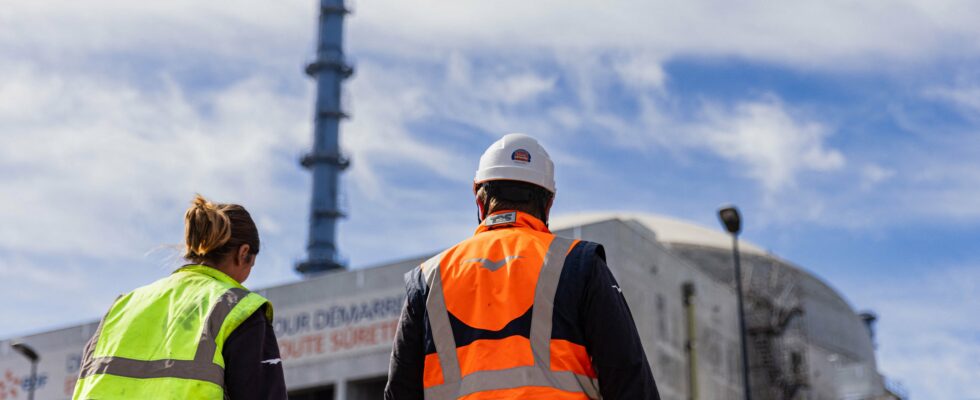For the Flamanville EPR, there is good news and bad news: EDF announced on Monday, September 2, that it would be necessary to wait three more months to see its new reactor supplying the electricity network, which will not receive its first electrons before “the end of autumn”, whereas the electrician had previously been counting on the end of summer.
But all is not lost: the energy company simultaneously announced that it had received the green light from the Nuclear Safety Authority (ASN), the industry’s watchdog, to launch production of the first electrons from the EPR, twelve years behind the initial schedule. Except that the “coupling”, i.e. the network connection operations that will allow French homes to benefit from the energy of the most powerful reactor (1,600 MW), the 57th in the fleet, will still have to wait.
“A test program to reach a power level of 25% will be implemented”, a stage during which the EPR “will be connected to the national electricity grid for the first time and will then produce electricity”, a deadline “planned for the end of autumn 2024”, the group specified in a press release.
The first nuclear fission chain reaction should nevertheless occur as early as Tuesday, September 3: “the night teams, who finally attack their workstation at 9:00 p.m., will initiate the physical action” that will bring the reactor to be “in this state of initiated and maintained stable nuclear reaction,” Régis Clément, deputy director of the French group’s nuclear production division, told the press. The operation should “take about ten hours,” he specified.
“To go to the coupling, we are talking about the end of autumn, because ahead of us, we have a fairly substantial test program,” said Régis Clément, who announced a rise “in successive stages”, before the nuclear core could “show its credentials”. EDF CEO Luc Rémont had assured that the divergence, a major stage in the reactor start-up operations, would be “imminent” at the beginning of July. If it only began on Monday, it is because the Flamanville teams encountered “hazards”, which led to “a certain number of additional operations” to be carried out during the summer, according to Régis Clément. As for full power, promised until then by the end of the year, it will take “several months”, according to Régis Clément, who did not give a new date.
EDF revises upwards its estimate of nuclear production for 2024
Concretely, it will still take some time before Flamanville’s electricity arrives on the other side of the socket. But what makes this EPR so exceptional? On franceinfo, Emmanuelle Galichet, a teacher-researcher in nuclear physics for the National Conservatory of Arts and Crafts (CNAM), declared on Tuesday, September 3: “[On peut alimenter] about 2 million people with one reactor. It’s really colossal.”
Although EDF has nevertheless obtained the “go” from the ASN to launch operations and take a new crucial step, this is yet another setback for a project that is already 12 years behind schedule for this new pressurized water reactor, the 4th of this type installed in the world. While President Emmanuel Macron has decided to relaunch nuclear power, by ordering six EPR2 reactors (and eight additional ones as an option) from the energy company, the start-up of the Flamanville EPR, even if it was decided well before, has a highly symbolic dimension.
In addition to the ASN authorization, the other good news came from the existing fleet: EDF has significantly revised upwards its estimate of nuclear production for the year 2024, now between 340 and 360 TWh, compared to a range of 315 to 345 TWh initially planned, an increase not including the Flamanville EPR. “The other 56 reactors are performing better than what we had integrated,” said Regis Clément, so much so that the production of “the EPR will arrive in addition.”
Many setbacks
“The ‘corrosion’ file was less sensitive than expected,” he added. “This revision of the nuclear production estimate for 2024 is based on the improvement in the performance of unit shutdowns, industrial control of inspections and repair sites related to the stress corrosion file, and the absence of major climatic hazards during the summer,” according to the EDF press release.
Technical difficulties, poor workmanship, manufacturing defects, welding faults… The many setbacks that have affected the EPR construction site have repeatedly threatened to shut it down. In 2011, the Fukushima nuclear accident in Japan reopened the nuclear debate, while François Hollande, who came to power in 2012, wanted to reduce the share of nuclear power in France to 50% in electricity production. At the same time, the bill for what can be described as an industrial mess is increasing, now estimated at 13.2 billion euros by EDF, four times the initial estimate of 3.3 billion. In 2020, the Court of Auditors had estimated it at 19 billion, including in particular the “additional financing costs”. It should be noted that the last power plants to enter service were those of Chooz (Ardennes), in 2000 and Civaux (Vienne), in 2002.
